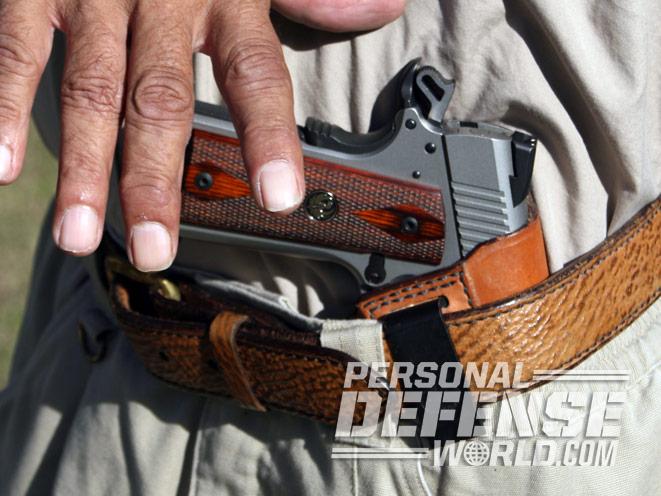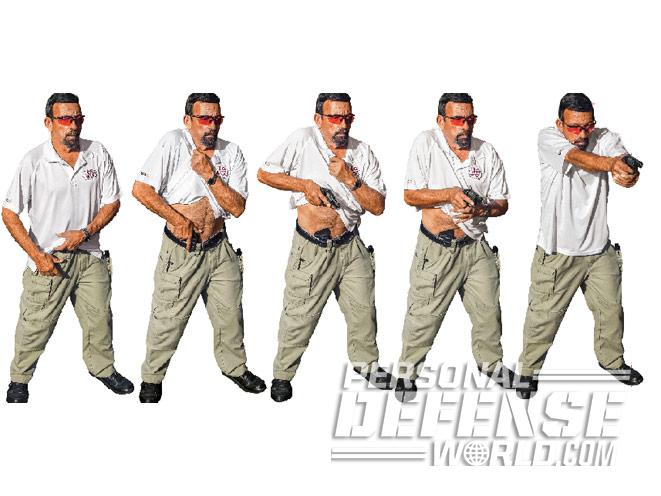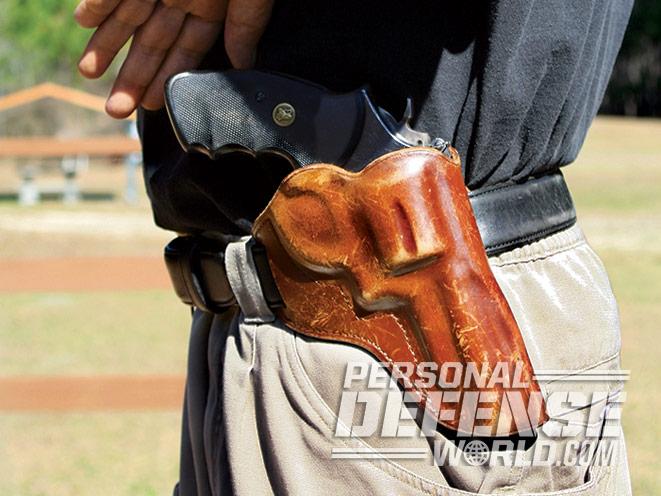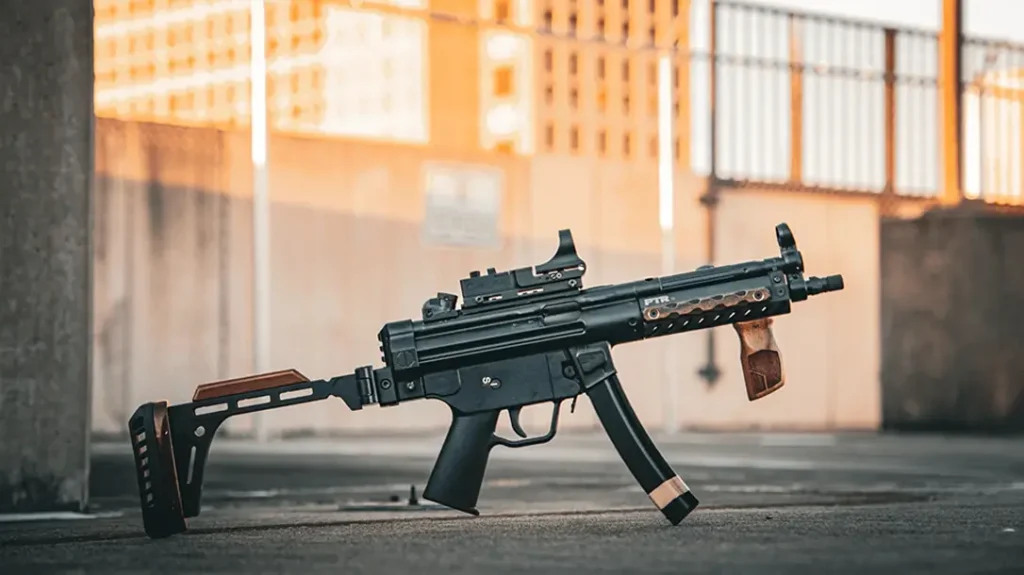The most popular carry position, strong-side hip, is not necessarily the best for every user or every situation. Consider two well-proven alternatives instead. Let’s examine two time-proven alternatives: appendix carry and cross-draw. In each case we’ll look at the downsides that made them less than prevalent today, but we’ll also consider the upsides that make these carry positions optimum choices for some people in some situations.
Appendix Carry

Appendix carry means the gun is holstered in front of the hip, on the dominant hand side. In concealed carry today, it’s popular to compare holster positions to an analog clock face. Looking down, if your navel is 12 o’clock, appendix carry is somewhere between there and 3 o’clock if you’re right-handed, or between noon and 9 o’clock if you’re a southpaw.
Advertisement — Continue Reading Below
Strengths: When we’re standing relaxed, walking or doing almost any normal activity, our hands are more likely to be forward of our hips than behind our backs. Therefore, when the stimulus comes to draw, appendix carry often puts the master hand closer to the gun than behind-the-hip carry. When Jerry “the Burner” Barnhart was the world champ in International Practical Shooting Confederation (IPSC) competition, he carried his match pistol at the appendix in a speed rig. So did many of those who tried, usually unsuccessfully, to beat him.
Today, a number of highly skilled shooters “carry appendix.” Because an outside-the-belt holster tends to bulge under concealing garments, most of these pistoleros holster their weapons inside the waistband in what are now called AIWB holsters, for appendix inside the waistband. If one needs to wear the gun under a closed-front concealment garment—an untucked shirt or T-shirt, a pullover sweater or anything similar—the fastest way to get the concealing fabric out of the way so the dominant hand can access the pistol is for the support hand to pull the garment up and clear. Positioned forward of the hip, appendix holsters put the gun closer to that clearing support hand, further speeding the draw. That technique of drawing from under a closed-front garment by ripping the garment upward with the support hand was developed by famed combat master Ken Hackathorn, and has long been appropriately called the “Hackathorn Rip.” It works at its best and fastest with appendix carry.
For a quarter century or so I’ve known Craig Douglas, the now-retired undercover cop who, for most of his career, taught under the sobriquet Southnarc. Craig, in my opinion, did more to popularize AIWB carry than anyone else. His combination of street experience, advanced martial-arts skills and combat shooting knowledge taught him that he could best defend the gun from a grab in that position, could most quickly access it in a belly-to-belly fight in that position and could best keep it from being spotted in that position. Today, famous instructors such as Gabe Suarez are proponents of AIWB. I once watched Todd Louis Green win the Polite Society match at Tom Givens’ National Tactical Conference, where all contestants had to draw from concealment. Todd smoked all the rest of us, drawing a Heckler & Koch .45 auto from an AIWB holster concealed beneath an untucked polo shirt.
Advertisement — Continue Reading Below

Disadvantages: Comfort and safety are the main issues with appendix carry. Depending on the exact holster position, one’s own loaded gun is pointed somewhere between the private parts and the juncture of the hip and thigh, beneath which we find the femoral artery. If carelessness, stress or Murphy’s Law come into play and the pistol discharges, particularly if the user is bent forward or in a seated position, what might have been a flashburn on the butt with a behind-the-hip holster can become a catastrophic gunshot wound resulting in something between castration and death. Yes, it has happened. This is why some action handgun competitions, from the International Defensive Pistol Association to the NRA’s Practical Police Course, do not allow appendix carry.
Comfort issues correlate largely with “body shape” issues. If you spend more time at Weight Watchers meetings than you do at the gym, “abdominal overlap” can get in the way between your hand and your gun when you need a fast draw, particularly when seated. If you have “low-riding hips” or a longer barreled handgun, the muzzle may dig painfully into your groin area when you are seated.
Advertisement — Continue Reading Below
Appendix carry often works better for women than for men. With (generally) higher hips and shorter torsos, the female pistol-packer often finds appendix carry more comfortable and proportionally faster than might her brother or husband of the same height. Famed instructor Kathy Jackson comes to mind; she teaches with her trademark Glock 9mm carried AIWB, the same way she carries it 24/7 on her own time.
RELATED STORY: Massad Ayoob’s 5 Methods of Concealed Quick-Draw
Safety Concerns: Leaning back at the hips when you holster angles the muzzle away from the lower abdomen and thighs, reducing the likelihood of a serious wound if something trips the trigger of the loaded gun during the holstering process. Thanks to veteran instructor Phil Wong for the tip.
Advertisement — Continue Reading Below
Many AIWB wearers consider it “safety insurance” to carry a pistol with an exposed hammer, instead of a striker-fired auto or a “hammerless” revolver. The reason is that when holstering, the shooter can keep the thumb firmly on the hammer, holding a double-action hammer down or a single-action auto’s hammer back, giving one more safety net in case something trips the trigger during the holstering process. A manual safety lever in the “safe” position is one more safety net in this situation.
Concealed Cross-Draw

Cross-draw carry means that the gun is carried butt-forward on the side of the body opposite the dominant hand, so the shooter reaches across his torso to draw. It’s normally at waist level, but suspended under the opposite-side’s arm in a shoulder holster is also considered a form of cross-draw.
Advertisement — Continue Reading Below
Strengths: For someone constantly seated during periods at risk—the long-haul trucker or bodyguard/chauffeur behind the steering wheel, the banker at his desk, the wheelchair-bound individual, etc.—the reach to the gun is likely to be shorter, and the draw therefore likely faster. Being faster than an ankle holster or reaching into a pocket for a gun, the across-the-torso placement is also popular for backup guns. Forty-some years ago I spent some time researching the NYPD Stakeout Unit, where every member was required to carry two handguns and have immediate access to a long gun. Most wore their second handgun cross-draw, and the primary handgun on their strong-side hip. Two of the SOU’s most famous members; Jim Cirillo wore a spare Smith & Wesson .38 Special butt-forward in front of his left hip and his partner Bill Allard used a shoulder holster for one of his handguns when I visited them at work.
The popular sport of cowboy action shooting provides additional insights into this style of carry. Each competitor is required to carry two SA revolvers to supplement a lever-action rifle and an old-style shotgun. When I was active in the sport (I’ll still answer to “Camelback Kid”), most cowboy shooters carried their second sixgun cross-draw, having found it faster and more accurate than trying to become ambidextrous with revolvers worn with the butt to the rear on each hip.

There is also an “orthopedic” element to cross-draw. Some injuries to the strong-side hip area can make it agonizing to wear a firearm there, but the weight can be borne at the opposite hip. In fact, many people find that learning cross-draw with their dominant hand comes faster than learning conventional hip draw with their “weak” hand. Certain shoulder injuries, particularly those involving the rotator cuff it seems, can severely limit the ability of the patient to draw from a strong-side hip position but does not impede access to a holster firearm in a cross-draw position.
Advertisement — Continue Reading Below
RELATED STORY: Undercover Holsters For Concealed Carry
Some “bad back” and “bad hip” conditions require weight to be removed from the pelvic area as much as possible. After some hip (or abdominal) surgeries, doctors recommend that the patient not even wear a belt, let alone a belt laden with gun and ammo. A shoulder holster can be the answer here, and, of course, the shoulder rig is a type of cross-draw.
There can be tactical advantages to cross-draw. When danger is in the air but not sufficiently apparent yet to warrant drawing or displaying a gun, a handgun concealed on the opposite hip or opposite side of the torso allows the user to appear to fold his arms harmlessly across his chest (shoulder holster) or abdomen (belt-mounted cross-draw) and not reveal that his gun hand is already under his jacket and holding his weapon in a drawing grasp. This can greatly speed the Good Guy’s reaction time if the Bad Guy suddenly goes really “bad.”
Advertisement — Continue Reading Below

Finally, the cross-draw is extremely fast for weak-hand access. One need only do the “cavalry draw” from the 19th century. When the gun is holstered butt-forward on the hip, the hand on that side turns palm out and thumb back, pulls the gun’s butt up and slightly back, and rotates the muzzle up and thrusts it toward the target as it clears. Weak-hand draw executed thusly can be surprisingly fast—it was, according to legend, the way Wild Bill Hickok drew with each hand the twin Colt Navy .36-caliber revolvers he carried butt-forward on each side—and without the muzzle crossing the shooter’s own body.
Disadvantages: The forward-facing gun butt is pointed toward one’s opponent when the latter attacks from the front, and this can literally allow him to grab your gun before you do. This can be ameliorated somewhat by the “front cross-draw” position, closer to the centerline of the navel or belt buckle. If you turn the holster side of your body toward the opponent, the butt is pointed more away from him.
When worn in true cross-draw style (opposite hip instead of front cross-draw), the gun arm has a longer reach. A man with a large abdomen or wide shoulders may not be able to reach his right hand to a proper grasping position for a gun on his left hip, even with the gun’s butt forward. For concealed carry, this would mandate a more forward placement and, as with appendix carry, would more often require a closed-front garment to assure concealment.
Advertisement — Continue Reading Below
RELATED STORY: For The Ladies – Tips On How To Carry Concealed In Any Situation
As noted earlier, cross-draw is not allowed in certain “combat shooting” sports. It is also forbidden by a number of private shooting academies, police academies and police departments. The reason is that when standing square to the target, the cross-draw can swing the muzzle of the loaded gun across the shooter on the holster side, and perhaps even the range safety officer behind the firing line. Being banned in so many venues somewhat limits the shooter’s ability to practice in controlled stress situations and develop safe quick-draw skills.
Safety Concerns: When working from cross-draw, always raise the support arm so it won’t be crossed. At my school, we teach raising the support arm to a tactical block position to perform double duty. Always start with the holster-side hip edged toward the target or threat. Pull the gun out and thrust it immediately into the target and you will eliminate lateral sweep. This also gets the gun on target faster and prevents momentum from sweeping the gun past the target laterally. Holstering is done with the same elements in place.
While appendix carry and cross-draw carry are not the choices for the majority of shooters, a study of each method shows why, for some people and some circumstances, they may be optimum. Choose wisely, practice well, practice often and practice safely.

































